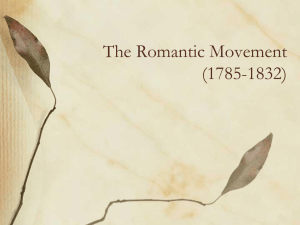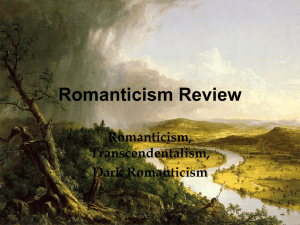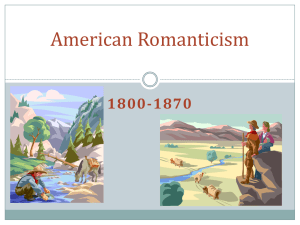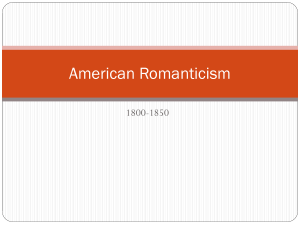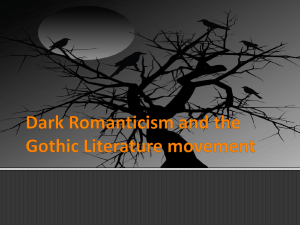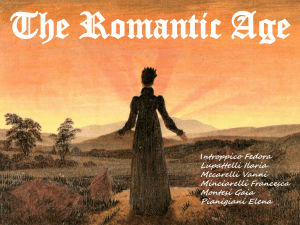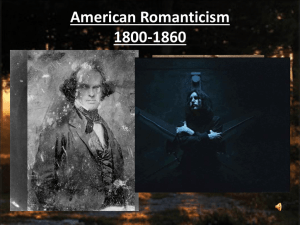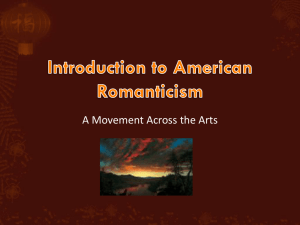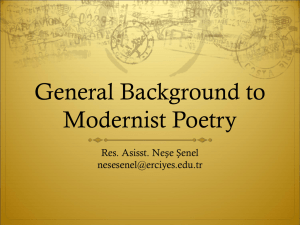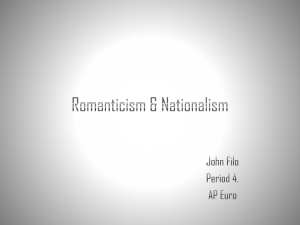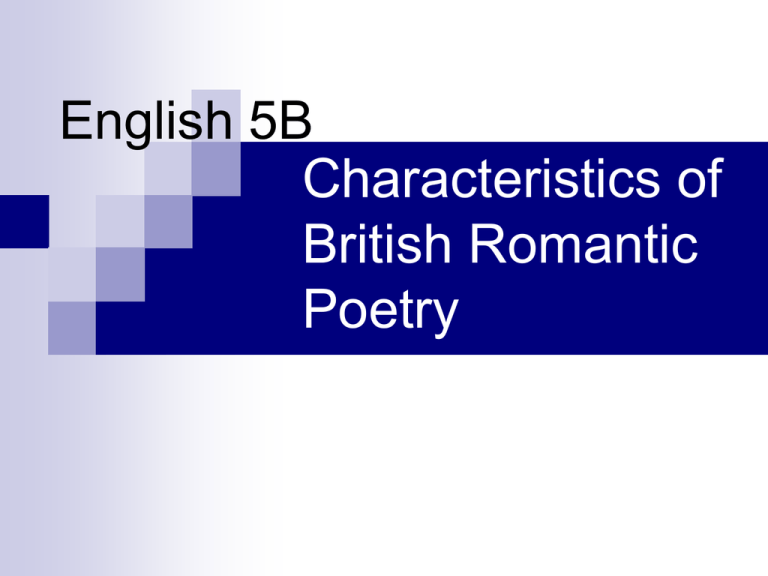
English 5B
Characteristics of
British Romantic
Poetry
What does “Romantic” mean?
The word romantic first became current in 18thcentury English and originally meant “romancelike,” that is, resembling the strange, fanciful,
mythical character of medieval romances. The
word came to be associated with interest in the
Middle Ages, the emerging taste for wild
scenery, ruins and other “sublime” locations, a
tendency reflected in the increasing emphasis in
aesthetic theory on the sublime as opposed to
the beautiful.
Romanticism
In Europe, Romanticism flourished in England,
Germany, and France
It elevated the individual, the passions, and the
inner life, embracing a more dramatic, personal,
and emotional style--even to the point of
melancholic emotion
Romanticism followed a period we call the
Enlightenment. During the 18th century, in a
reaction against Enlightenment ideas, feeling
began to be considered more important than
reason, both in literature and in ethics
What was the Enlightenment?
A broad intellectual movement in eighteenthcentury Europe, particularly Britain, France and
Germany, characterized by a rejection of
superstition and mystery and an optimism
concerning the power of human reasoning and
scientific endeavor. It is also referred to as “The
Age of Reason.” It was both within and against
Enlightenment thought that Romanticism can be
said to have been conceived.
What is Neoclassicism?
An 18th-century artistic movement, associated
with the Enlightenment, drawing on classical
models and emphasizing reason, harmony, and
restraint. Literally, “new classicism,” it marked a
renewed interest in the literary and artistic
theories of ancient Greece and Rome and an
attempt to reformulate them for contemporary
society.
British Romanticism
The Romantic period in British Literature
(roughly 1780-1832) stands between and
connects the Enlightenment’s promotion of
commerce, reason, and liberty and the Victorian
experience of industrialization and empire.
Romanticism in both artistic production and
cultural reception elevated aesthetic practice to
an almost divine activity, a realm wherein the
individual might forge his or her very self as an
ethical, political, and creative being.
German Precursors
Sturm und Drang, conventionally
translated as "Storm and Stress,” was a
proto-Romantic movement in German
literature and music
It took place from the late 1760s through
the early 1780s
Sturm und Drang
Individual subjectivity, and, in particular,
extremes of emotion were given free
expression in reaction to the perceived
constraints of rationalism imposed by the
Enlightenment and associated aesthetic
movements
German Romanticism
German Romanticism was the dominant
movement of the late 18th and early 19th
centuries in the philosophy, art, and culture of
German-speaking countries
It developed relatively late compared to its
English counterpart, coinciding in its early years
with the movement known as German
Classicism or Weimar Classicism, which it
opposed
German Romanticism
The early German romantics tried to create a
new synthesis of art, philosophy, and science,
looking to the Middle Ages as a simpler, more
integrated period.
Later German Romanticism emphasized the
tension between the everyday world and the
seemingly irrational and supernatural projections
of creative genius.
German Romanticism: Goethe
Johann Wolfgang von Goethe (1749-1832) said
that “classical” meant “health,” and “romantic”
meant “illness
Goethe was one of the key figures of German
literature and the movement of Weimar
Classicism in the late 18th and early 19th
centuries; this movement coincides with the
Enlightenment and Romanticism
German Romanticism: Goethe
The Sorrows of Young Werther (1774) is a novel
that was the first popular success of Goethe. It
was very important in establishing the image of
the introspective, self-pitying, melancholic
Romantic hero
It is about a sensitive and intelligent young man
who is tormented by his own intellectual
speculations and love for a girl who is engaged
to someone else
German Romanticism: Goethe
Ultimately, Werther shoots himself
The novel was credited with causing a wave of
suicides among young romantics throughout
Europe
German Romantic Composers
Carl Maria von Weber
Franz Schubert
Robert Schumann
Felix Mendelssohn Bartholdy
Franz Liszt
Johannes Brahms
Richard Wagner
Ludwig van Beethoven
French Romanticism
French literature from the first half of the 19th
century was dominated by Romanticism
English and German influences were important
in defining the interests of the French Romantics
They include Shakespeare, Sir Walter Scott,
Lord Byron, Goethe, and Friedrich Schiller
English and German influences on French
Romanticism encouraged interests in. . .
The historical novel
The Medieval Romance
Traditional myths
Nationalism
The "roman noir" (Gothic novel)
English and German influences on French
Romanticism encouraged interests in. . .
Lyricism
Sentimentalism
Descriptions of the natural world
The common man
Exoticism and orientalism
The myth of the romantic hero
Impact and Authors (France)
The effect of the romantic movement would
continue to be felt in the latter half of the century
in wildly diverse literary developments, such as
“realism,” “symbolism,” and the so-called fin de
siècle “decadent” movement
Authors of prose, poetry, and drama include
Victor Hugo; Alexandre Dumas, père; FrançoisRené de Chateaubriand; Alphonse de
Lamartine; Gérard de Nerval; Charles Nodier;
Alfred de Musset; Théophile Gautier; and Alfred
de Vigny
A key concept in Romanticism is the
“sublime”
While the beautiful is calm and harmonious, the
sublime is majestic, wild, and sometimes
savage. Viewers are moved and often made
happy by the beautiful, but they are
overwhelmed, awe-struck, and sometimes
terrified by the sublime.
What is the sublime?
Often associated with huge, overpowering
natural phenomena like mountains, waterfalls,
turbulent seas, and thunderstorms, the
“delightful terror” inspired by sublime visions was
supposed both to remind viewers of their own
insignificance in the face of nature and divinity
and to inspire them with a sense of
transcendence.
How did the sublime relate to the beautiful?
Mere beauty was thought by the Romantics to
be inferior to the concept of the “sublime.” The
British writer and statesman Edmund Burke, who
was interested in categorizing aesthetic
responses, identified beauty with delicacy and
harmony, and he identified the sublime with
vastness, obscurity, and a capacity to inspire
terror.
The Falls of the Rhine at Schaffhausen
Philippe Jacques De Loutherbourg
Caspar David Friedrich
Wanderer Above the Sea of Fog
What shaped Romanticism?
At the turn of the century, fired by ideas of
personal and political liberty and of the energy
and sublimity of the natural world, artists, writers,
and intellectuals sought to break the bonds of
18th-century convention. Although the
philosophers Jean Jacques Rousseau (France)
and William Godwin (England) had great
influence, the French Revolution and its
aftermath had the strongest impact.
What shaped Romanticism?
In England, initial support for the French
Revolution was primarily utopian and idealistic
When the French failed to live up to
expectations, most English intellectuals
renounced the Revolution
However, the Romantic vision had taken forms
other than the political, and these continued to
develop
Romanticism emphasized. . .
Individualism
Creativity
Revolutionary political ideas
The use of the imagination over reason
Reverence for nature
Mystery
Transcendence
Synthesis
Universality
The beginnings of Romantic Poetry
In Lyrical Ballads (1798 and 1800), William
Wordsworth and Samuel Taylor Coleridge
presented and illustrated a liberating aesthetic:
poetry should express, in genuine language,
experience as filtered through personal emotion
and imagination; the truest experience was to be
found in nature. The concept of the sublime
strengthened this turn to nature; in wild country
sides, the power of the sublime could be felt
most immediately.
The beginnings of Romantic Poetry
In search of sublime moments, romantic poets
wrote about the marvelous and supernatural, the
exotic, and the medieval. But they also found
beauty in the lives of simple rural people and
aspects of the everyday world. Another
important subject of the Romantics was memory.
Wordsworth’s romanticism and originality is most
evident in his lengthy autobiographical poem,
The Prelude (1805–50).
British Romantic poets tend to. . .
Show exuberance and optimism--at times
revolutionary optimism--about the prospects for
changing the individual and society
Explore divisions within the human psyche
(between self and others and self and nature)
Strive after the infinite, not after limited
perfection
British Romantic poets tend to. . .
Emphasize individual expression, not imitation
and obedience to formal rules, in art
Emphasize the concrete, the sensuous, and the
particular in poetry
Treat poetry as an organic, living entity or whole
Valorize engagement with or return to nature as
the regenerator of imagination and guide for all
that is best in humankind
British Romantic poets tend to. . .
See the poet as “the rock of defense for human
nature” (Wordsworth); the poet has the power
reunite a fragmented self and society
Stress creative imagination as the source of art;
the mind at least partially creates what we call
“the world”
Cultivate theories of “poetic genius”
Revere and explore the subjective nature of
memory
British Romantic poets tend to. . .
Emphasize the emotional, or “passionate,”
element in human beings
Reject the neoclassical emphasis on decorum,
restraint, imitation of “general nature,” and
previous poets
Are obsessed with “originality” and “authority”:
they must “create a system,” or be “enslav'd by
another man’s” (Blake)
British Romantic poets tend to. . .
Treat poetry as an organic, living entity or whole
May replace the neatly rounded poem with a
“fragment”; to complete a poem is to kill it, to
destroy its growth as an organic, living entity
(Nature is profoundly an engine of process; it
never “finishes” anything)
British Romantic poets tend to. . .
Defy the moral codes of ordinary society
Believe that poetry does not so much delight and
teach (neoclassical requirements) as help the
reader undergo a poetic/spiritual experience
Attempt to forge a secular scripture, to overcome
“fallen” or “alienated” language
Favor the lyric over other types of poem (when a
Romantic poet writes an “ode,” he or she refers
to a state of mind, not so much to the poetic
genre)
“Poets are the hierophants of an unapprehended
inspiration; the mirrors of the gigantic shadows
which futurity casts upon the present; the words
which express what they understand not; the
trumpets which sing to battle, and feel not what
they inspire; the influence which is moved not,
but moves. Poets are the unacknowledged
legislators of the world.” Shelley (from “A Defnce
of Poetry”)
Who were the British Romantic poets?
There were many men and women we can
categorize as British Romantic poets
Today, we tend to focus on a “canon” of six
British Romantic Poets
These six were not all particularly popular in
their own time, however
Other men and women whose names are largely
forgotten were much more popular
The “canon” of British Romantic poets:
William Blake (1757-1827)
William Wordsworth (1770-1850)
Samuel Taylor Coleridge (1772-1834)
George Gordon, Lord Byron (1788-1824)
Percy Bysshe Shelley (1792-1822)
John Keats (1795-1821)
William Blake (1757-1827)
A printmaker and painter as well as a poet
Relatively unknown during his own time
Considered a madman by some
A mystic and a visionary
A believer in racial and sexual equality
A critic of conventional religion
Blake's "A Negro Hung Alive by the Ribs to a Gallows"
Blake’s illustration for his poem “The Grave”
Blake’s illustration for his poem “London”
William Wordsworth (1770-1850)
With Samuel Taylor Coleridge, he helped launch
the Romantic Age in English literature with their
1798 joint publication, Lyrical Ballads
Revolutionary as a young man
Was England's Poet Laureate from 1843 until
his death
William Wordsworth (1770-1850)
Wordsworth’s Preface to the Lyrical Ballads is
considered a central work of Romantic literary
theory.
In it, he discusses what he sees as the elements
of a new type of poetry, one based on the "real
language of men" and which avoids the poetic
diction of much eighteenth-century poetry.
Wordsworth also gives his famous definition of
poetry as "the spontaneous overflow of powerful
feelings from emotions recollected in tranquility."
“What is a Poet? . . .”
“He is a man speaking to men: a man, it is true,
endowed with more lively sensibility, more
enthusiasm and tenderness, who has a greater
knowledge of human nature, and a more
comprehensive soul, than are supposed to be
common among mankind; a man pleased with
his own passions and volitions, and who rejoices
more than other men in the spirit of life that is in
him; delighting to contemplate similar volitions
and passions as manifested in the goings-on of
the Universe, and habitually impelled to create
them where he does not find them.”
“. . . poetry is the spontaneous overflow of
powerful feelings: it takes its origin from emotion
recollected in tranquility: the emotion is
contemplated till, by a species of reaction, the
tranquility gradually disappears, and an emotion,
kindred to that which was before the subject of
contemplation, is gradually produced, and does
itself actually exist in the mind. . . .”
“. . .In this mood successful composition
generally begins, and in a mood similar to this it
is carried on; but the emotion, of whatever kind,
and in whatever degree, from various causes, is
qualified by various pleasures, so that in
describing any passions whatsoever, which are
voluntarily described, the mind will, upon the
whole, be in a state of enjoyment.” (from the
Preface to the Lyrical Ballads)
Samuel Taylor Coleridge (1772-1834)
Poet, critic, philosopher
With William Wordsworth, one of the founders of
the Romantic Movement in England and one of
the “Lake Poets”
Best known for his poems “The Rime of the
Ancient Mariner” and “Kubla Khan,” as well as
his major prose work, Biographia Literaria
Attacked for political radicalism
Samuel Taylor Coleridge (17721834)
Coleridge was influenced by the philosopher
William Godwin
Mary Wollstonecraft Godwin, Godwin’s
daughter, recalled hiding behind the sofa as a
child to hear Coleridge recite “The Rime of the
Ancient Mariner”
Mary Godwin eventually became Mary Shelley,
wife of Percy Bysshe Shelley
She mentions “The Rime of the Ancient Mariner”
twice in her novel Frankenstein
Some of the descriptions in the novel echo the
poem indirectly
Lord Byron (1788-1824)
Lady Caroline Lamb called him “mad, bad, and
dangerous to know”
Of the six poets, he was the only “best seller”
during his lifetime, mainly because he was a
celebrity
He was famous for his sexual attractiveness,
charisma, extravagant living, numerous and
scandalous love affairs, debts, separation from
his wife, and allegations of incest and what was
then called “sodomy”
He was a national hero to the Greeks because
he fought in their War of Independence
George Gordon, the sixth Lord Byron
Lord Byron (1788-1824)
Byron falls into the period of Romantic poetry,
but much of his work looks back to the satiric
tradition of Pope and Dryden. In Canto III of Don
Juan, he expresses his detestation for poets
such as Wordsworth and Coleridge, who
disappointed the younger generation of
Romantic poets.
Byron was known for his creation of the
Byronic Hero, whose attributes include
Great talent
Great passion
Sexual attractiveness
Contempt for society and social institutions
Contempt for rank and privilege
Being thwarted in love by social constraint or
death
Rebellion
Exile
An unsavory and hidden past
Arrogance
Overconfidence
Lack of foresight
Self-destruction
In short, a man much like Lord Byron himself.
Byron trivia:
His mother and his daughter were both
mathematicians
His daughter, Ada Lovelace, collaborated
with Charles Babbage on the “analytical
engine,” a predecessor of modern
computers
Though famous for his good looks and sex
appeal, he had a club foot
Percy Bysshe Shelley (1792-1822)
An idealist and advocate for social justice
A strong skeptic
A notorious and denigrated figure in his life (he
was a political radical, and he abandoned his
pregnant wife and his child)
The idol of the next two or three generations of
poets
Famous for his association with John Keats and
Lord Byron
His writing significantly influenced the American
Revolution
John Keats (1795-1821)
His work was critical attacked in the periodicals
of the day
His posthumous influence on poets such as
Alfred Tennyson was immense
His poetry is characterized by elaborate word
choice and sensual imagery
Keats's letters, which expound on his aesthetic
theory of “negative capability,” are almost as
famous today as his poetry
“Negative Capability”
In a letter he wrote in December of 1817, Keats
stated, “. . . it struck me, what quality went to
form a Man of Achievement especially in
literature & which Shakespeare possessed so
enormously--I mean Negative Capability, that is
when man is capable of being in uncertainties,
Mysteries, doubts without any irritable reaching
after fact & reason.
Important Terms
The Enlightenment
Neoclassicism
Romanticism
Sublime
Utopian
Fin de siècle
Important Terms
Transcendence
Synthesis
Lyric
Lyrical Ballads
“The Preface” [to the Lyrical Ballads]
Orientalism
Important Terms
Sturm and Drang
Gothic
Byronic

